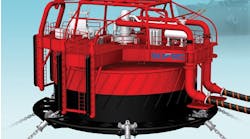Power Quality Management - Improved control and monitoring of offshore power networks
The efficiency and reliability of power networks are as important to offshore operations as to any industrial activity. An important contribution to the smooth running of such operations can be made by monitoring power quality, for which purpose high-performance measure-ment systems are available from Unipower.
As deregulation spreads around the world, power is increasingly perceived as a product subject to the demands of quality assurance, says export area manager Christer Carlborg. Like other important products, it is increasingly subject to standards such as the international standard EN 50160. Though probably not widely appreciated, the cost of disruptions to power networks is huge: $26 billion a year in lost time and revenue, according to an EPRI study.
The smooth functioning of the power network may be upset by various phenomena: short-lived drops or surges in voltage, known as sags and swells, sudden disturbances known as transients, caused by lightning or load switching, harmonic distortion, flicker, frequency variation, and unbalance. Sudden changes in the voltage level across the network can be caused by switching on or off large consumers. The occurrence of such phenomena can have severe effects, damaging or even knocking out equipment, and in the worst case causing the shutdown or failure of the whole system. Meanwhile, as ever more sensitive equipment such as electronic control systems is introduced, the vulnerability of power networks is growing.
null
A power quality problem can be defined as any voltage, current, or frequency deviations that result in failure or mis-operation. Uni-power's products are intended to enable poor power quality to be discovered before disruption occurs. They include portable analyzers and systems for permanent installation that provide round-the-clock monitoring, as well as instruments for special applications. Up to 150 different parameters relating to voltage, frequency, power, harmonics, and other variables are monitored.
Permanently installed monitors can be connected with the PQ Secure management system to provide an overview of the network functioning. Alarms can be given if the data indicate a departure from normal functioning.
For an oil production plant, some five to 10 monitoring systems would be required, typically installed at critical points, such as generators, transformers, and main machinery, Carlborg says.
For more information, contact: Christer Carlborg, Unipower. Tel +46 322 63 80 20, fax +46 322 63 80 60. [email protected], www.unipower.se




